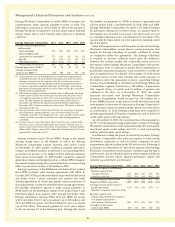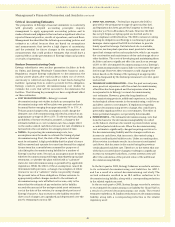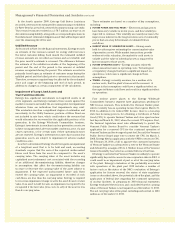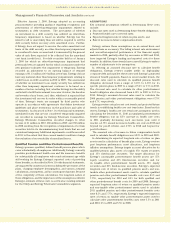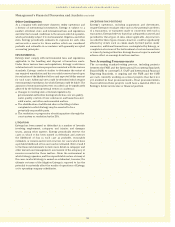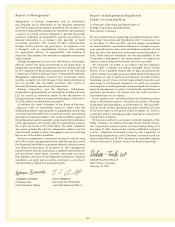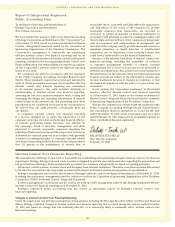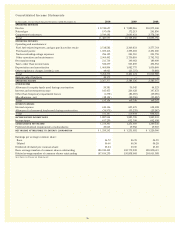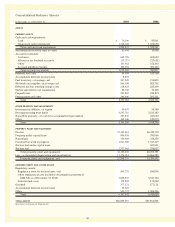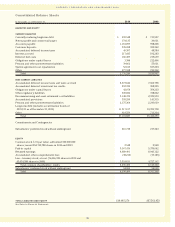Entergy 2010 Annual Report Download - page 53
Download and view the complete annual report
Please find page 53 of the 2010 Entergy annual report below. You can navigate through the pages in the report by either clicking on the pages listed below, or by using the keyword search tool below to find specific information within the annual report.
ENTERGY CORPORATION AND SUBSIDIARIES 2010
Management’s Financial Discussion and Analysis continued
Effective January 1, 2009, Entergy adopted an accounting
pronouncement providing guidance regarding recognition and
presentation of other-than-temporary impairments related to
investments in debt securities. The assessment of whether
an investment in a debt security has suffered an other-than-
temporary impairment is based on whether Entergy has the
intent to sell or more likely than not will be required to sell the
debt security before recovery of its amortized costs. Further,
if Entergy does not expect to recover the entire amortized cost
basis of the debt security, an other-than-temporary-impairment
is considered to have occurred and it is measured by the present
value of cash flows expected to be collected less the amortized
cost basis (credit loss). For debt securities held as of January
1, 2009 for which an other-than-temporary impairment had
previously been recognized but for which assessment under the
new guidance indicates this impairment is temporary, Entergy
recorded an adjustment to its opening balance of retained
earnings of $11.3 million ($6.4 million net-of-tax). Entergy did not
have any material other than temporary impairments relating to
credit losses on debt securities in 2010 or 2009. The assessment
of whether an investment in an equity security has suffered an
other than temporary impairment continues to be based on a
number of factors including, first, whether Entergy has the ability
and intent to hold the investment to recover its value, the duration
and severity of any losses, and, then, whether it is expected that
the investment will recover its value within a reasonable period
of time. Entergy’s trusts are managed by third parties who
operate in accordance with agreements that define investment
guidelines and place restrictions on the purchases and sales of
investments. As discussed in Note 1 to the financial statements,
unrealized losses that are not considered temporarily impaired
are recorded in earnings for Entergy Wholesale Commodities.
Entergy Wholesale Commodities recorded charges to other
income of $1 million in 2010, $86 million in 2009, and $50 million
in 2008 resulting from the recognition of impairments of certain
securities held in its decommissioning trust funds that are not
considered temporary. Additional impairments could be recorded
in 2011 to the extent that then current market conditions change
the evaluation of recoverability of unrealized losses.
Qualified Pension and Other Postretirement Benefits
Entergy sponsors qualified, defined benefit pension plans which
cover substantially all employees. Additionally, Entergy currently
provides postretirement health care and life insurance benefits
for substantially all employees who reach retirement age while
still working for Entergy. Entergy’s reported costs of providing
these benefits, as described in Note 11 to the financial statements,
are impacted by numerous factors including the provisions of the
plans, changing employee demographics, and various actuarial
calculations, assumptions, and accounting mechanisms. Because
of the complexity of these calculations, the long-term nature of
these obligations, and the importance of the assumptions utilized,
Entergy’s estimate of these costs is a critical accounting estimate
for the Utility and Entergy Wholesale Commodities segments.
ASSUMPTIONS
Key actuarial assumptions utilized in determining these costs
include:
n Discount rates used in determining future benefit obligations;
n Projected health care cost trend rates;
n Expected long-term rate of return on plan assets; and
n Rate of increase in future compensation levels.
Entergy reviews these assumptions on an annual basis and
adjusts them as necessary. The falling interest rate environment
and worse-than-expected performance of the financial equity
markets in 2008, partially offset by recoveries in 2009 and 2010,
have impacted Entergy’s funding and reported costs for these
benefits. In addition, these trends have caused Entergy to make a
number of adjustments to its assumptions.
In selecting an assumed discount rate to calculate benefit
obligations, Entergy reviews market yields on high-quality
corporate debt and matches these rates with Entergy’s projected
stream of benefit payments. Based on recent market trends, the
discount rates used to calculate its qualified pension benefit
obligation decreased from a range of 6.10% to 6.30% for its
specific pension plans in 2009 to a range of 5.6% to 5.7% in 2010.
The discount rate used to calculate its other postretirement
benefit obligation also decreased from 6.10% in 2009 to 5.5% in
2010. Entergy’s assumed discount rates used to calculate the
2008 pension and other postretirement obligations were 6.75%
and 6.7%, respectively.
Entergy reviews actual recent cost trends and projected future
trends in establishing health care cost trend rates. Based on this
review, Entergy’s health care cost trend rate assumption used in
calculating the December 31, 2010 accumulated postretirement
benefit obligation was an 8.5% increase in health care costs
in 2011 gradually decreasing each successive year, until it
reaches a 4.75% annual increase in health care costs in 2019 and
beyond for pre-65 retirees and 4.75% in 2018 and beyond for
post-65 retirees.
The assumed rate of increase in future compensation levels
used to calculate benefit obligations was 4.23% in 2010 and 2009.
In determining its expected long-term rate of return on plan
assets used in calculation of benefit plan costs, Entergy reviews
past long-term performance, asset allocations, and long-term
inflation assumptions. Entergy targets an asset allocation for its
qualified pension plan assets of roughly 65% equity securities
and 35% fixed-income securities. The target allocations for
Entergy’s non-taxable postretirement benefit assets are 55%
equity securities and 45% fixed-income securities and, for
its taxable other postretirement benefit assets, 35% equity
securities and 65% fixed-income securities. Entergy’s expected
long-term rate of return on qualified pension assets and non-
taxable other postretirement assets used to calculate qualified
pension and other postretirement benefits costs was 8.5% and
7.75%, respectively for 2010 and 8.5% for both qualified and
other postretirement benefit costs for 2009 and 2008. Entergy’s
expected long-term rates of return on qualified pension assets
and non-taxable other postretirement assets used to calculate
2011 qualified pension and other postretirement benefits costs
were 8.5% and 7.75%, respectively. Entergy’s expected long-term
rates of return on taxable other postretirement assets used to
calculate other postretirement benefits costs were 5.5% in 2011
and 2010, 6% in 2009 and 5.5% in 2008.
51









